
82 Journal of Mining and Earth Sciences Vol. 65, Issue 6 (2024) 82 – 89
Potential using of marine sand in coastal areas of
Vietnam to create concrete for rural roads
Nu Thi Nguyen1,*, Son Truong Bui1, Dung Ngoc Nguyen1,2, Tuan Dinh
Vu1, Anh Tuan Bui1, Hieu Xuan Do1, Nghia Van Chu1, Phuong Lam Thi Nguyen1,
Thai Van Le3
1 Hanoi University of Mining and Geology, Hanoi, Vietnam
2 Polytechnique Montreal, Montreal, Canada
3 Dong Phuong Inspection and Investigation Consultant Joint Stock Company, Hai Duong, Vietnam
ARTICLE INFO
ABSTRACT
Article history:
Received 23rd June 2024
Revised 6th Oct. 2024
Accepted 28th Oct. 2024
In Vietnam, there is not enough sand from the river for the construction
operation, and it is necessary to find other resources to replace it. Marine
sand was distributed in large areas in the coastal area of Vietnam and was
not used for rural roads. This paper presents experimental results on the
workability and compressive strength of concrete which was made from
Nghe An and Ha Tinh marine sand. The particle size of two marine sands is
not fully suitable for use as fine aggregates in concrete according to TCVN
7570:2006. The Ha Tinh sand was more suitable for use as fine aggregates
in concrete than Nghe An sand. Three grades of concrete (M20, M25, M30)
were designed for testing. Fifty-four samples of concrete were mixed and
cured for 3, 7, and 28 days. Results showed that the compressive strength of
Ha Tinh concrete achieved the requirements of M20, M25, and M30 grade -
concrete. Otherwise, the compressive strength of Nghe An concrete has only
achieved the requirements of M10, M15, and M20 grade – concrete. The
research results also showed that the concrete made from Ha Tinh sand can
be used for the A, B, C, and D grades of rural roads and the concrete made
from Nghe An sand can only be used for the C, D grades of rural roads. The
workability of all concrete mixtures met the requirements of Vietnamese
standards. The sea sand in the coastal area of Vietnam has enormous
potential to produce concrete for rural roads.
Copyright © 2024 Hanoi University of Mining and Geology. All rights reserved.
Keywords:
Compressive strength,
Concrete,
Marine sand,
Rural road.
1. Introduction
Nowadays, Vietnam’s total sand volume is
about 2.3 million m3 and only meets 60 to 65% of
the demand for sand in construction (MONRE,
2020). The sand volume for the concrete
_____________________
*Corresponding author
E - mail: nguyenthinu@humg.edu.vn
DOI: 10.46326/JMES.2024.65(6).08

Nu Thi Nguyen et al./Journal of Mining and Earth Sciences 65 (6), 82 – 89 83
production was only 30% of the total demand
needed. So, it is necessary to find other
replacement resources for sand in construction.
Finding other resources to replace aggregate in
concrete is a promising avenue (Nguyen et al.,
2019; Bui et al., 2020). In Vietnam, there is a lot of
sand distributed along the coastal area which can
be used as fine aggregate. Therefore, the
investigation of the potential use of this material
in concrete is necessary in construction practices
(MONRE, 2020).
The use of marine sediments has been
studied by some authors elsewhere. Sanjaya
(2021) indicated that marine sand can be used as
fine aggregates in concrete. Dredged marine sand
(DMS) can also be used for making concrete and
the mechanical and durability properties of this
concrete have been studied by Limeira et al.
(2010, 2011a, 2011b), Padan (1983), Dias et al.
(2008), Huiguang et al. (2011). Limeira et al.
(2010) studied three concretes made from DMS
and indicated that the compressive strength of
those samples met the minimum of 30 MPa. Test
results also showed that the fresh and hardened
properties of concretes made with DMS
approached the results of the control concrete.
Limeira et al. (2011a) researched the mechanical
and durability properties of concretes fabricated
with dredged marine sand (DMS) as a fine
granular corrector in partial substitution of raw
sand (from 15% to up to 50% by raw sand mass)
and showed that those properties achieved the
requirement of concrete for harbor pavement.
From previous studies, marine sand has the
potential to be used as fine aggregates in concrete.
In Vietnam, marine sand has been studied to be
used for fine aggregates in concrete (Le, 2005,
2006; Tran, 2000; To, 2004; Hoang, 2011;
Nguyen, 2011). Le (2006) used marine sand with
a small content of salt to make concrete and
indicated that the compressive strength and
flexural tensile strength equaled 90÷92% of that
made with normal fine aggregates. Nguyen
(2011) showed that CSSB preparations were used
to treat salt in marine sand and after that sand can
be used to construct dyke in the Can Gio area.
Nevertheless, the use of marine sand for concrete
pavement is still limited. So, in this study, marine
sand from Ha Tinh and Nghe An province will,
therefore, be used to investigate the potential of
these materials to make concrete for rural roads.
The workability and the compressive strength of
concrete were evaluated. In addition, the
compressive strengths at 3, 7, and 28 days of
curing were investigated.
2. Materials and methods
2.1. Materials
In this study, components of concrete
included marine sand (fine aggregates), coarse
aggregates, and water. The fine aggregates were
collected in the coastal area of Nghe An and Ha
Tinh province (Figure 1).
a) b)
Figure 1. Marine sand samples in the coastal area
of Ha Tinh (a) and Nghe An (b).
The particle size distribution of marine sand
was determined according to the Vietnam
Construction Standard TCVN 5772:2006-2. The
physical properties of these samples were also
performed according to the Vietnam Construction
Standard TCVN 5772:2006. The particle size and
physical properties of marine sand are shown in
Table 1 and Figure 2.
Figure 2. Particle size distribution of marine
sand in the coastal area of Nghe An and Ha Tinh
provinces.

84 Nu Thi Nguyen et al./Journal of Mining and Earth Sciences 65 (6), 82 – 89
As shown in Figure 2 and Table 1, the particle
size of two marine sands is not fully suitable for
use as fine aggregates in concrete according to
TCVN 7570:2006. In this study, these sands are
also used to make concrete for rural roads
because of their benefits such as large volumes,
and on-site mining. The Fineness modulus of Ha
Tinh sand and Nghe An sand was 1.80 and 0.93
respectively. The Fineness modulus of Ha Tinh
sand was higher than that of Nghe An sand. It can
be seen that the Ha Tinh sand was more suitable
for use as fine aggregates in concrete than Nghe
An sand. As compared with the study of Wu et al.
(2020), the bulk density and fineness modulus of
these sands are smaller than those of sea sand in
Tianjin China.
In this study, PCB cement from the But Son
factory was used. The chemical components and
physico-mechanical properties of cement
(Nguyen et al., 2020) are shown in Table 2.
Fresh water is used for mixing concrete and
meets the requirements of Vietnam standards.
Coarse aggregates have a specific gravity of 2,700
kg/m3 and a bulk density of 1,370 kg/m3. The
particle size of coarse aggregates is shown in
Figures 3, 4. It can be seen that the coarse
aggregates are suitable for use to create concrete.
Figure 3. Particle size distribution of coarse
aggregates.
Table 1. Physical properties of Ha Tinh sand and Nghe An sand.
No
Physical properties
Ha Tinh sand
Standard sand
Nghe An sand
1
Specific gravity, kg/m3
2650
2630
2560
2
Fineness modulus of sand (Mk)
1.80
2.72
0.93
3
Silt, clay, and dust content (%)
0.4
0
0.7
4
Salt content (%)
0.31
0
0.50
5
Organic impurities
MS (Brighter
than standard
color)
MS (Brighter
than standard
color)
MS (Brighter than
standard color)
6
Mica content, (%)
0.03
0
0.02
7
Bulk density, kg/m3
1450
1320
Table 2. Chemical components and physical properties of PCB cement (Nguyen et al., 2020).
No
Chemical components and Physical properties
PCB But Son Cement
1
Chemical component, %
SiO2
19.74
2
Al2O3
5.18
3
Fe2O3
3.11
4
CaO
63.14
5
MgO
1.61
6
Na2O
0.15
7
K2O
0.70
8
SO3
1.85
9
TiO2
0.12
10
LOI
2.58
11
Bulk density, kg/m3
1300
12
Specific gravity, kg/m3
3100
13
Compressive strength at 28 days curing (MPa)
40

Nu Thi Nguyen et al./Journal of Mining and Earth Sciences 65 (6), 82 – 89 85
Figure 4. Coarse aggregates.
2.2. Methods
First of all, the mixing proportions of concrete
were designed to meet the compressive strength
of 20 MPa, 25 MPa and 30 MPa, workability of 3÷5
cm. The methods were used to design
components of concrete based on Bolomey -
Scramtaev methods (Nguyen et al., 2019). After
that, the concrete mixture was tested for slump,
and if it met the requirements, the strength
compression test specimen was performed. In
case the concrete mixture did not achieve a slump,
the N/X ratio must be increased. According to
Table 3, the standard concrete of C20, C25, and
C30 needs less cement content, so the N/X ratio is
larger than concrete using marine sand.
Table 3. The mix proportions of the concrete.
No
1
2
3
Ha Tinh concrete
Samples
M20
M25
M30
Coarse aggregates, kg
1089
1074
1063
Fine aggregates
(marine sand), kg
813
783
752
Cement, C, kg
323
378
433
Water, W, lit
190
190
190
W/C
0.57
0.50
0.43
Nghe An concrete
Samples
B20
B25
B30
Coarse aggregates, kg
1089
1074
1063
Fine aggregates
(marine sand), kg
813
782
751
Cement, C, kg
323
377
433
Water, W, lit
190
190
190
W/C
0.57
0.50
0.43
Control concrete
Samples
C20
C25
C30
Coarse aggregates, kg
1085
1074
1063
Fine aggregates
(standard sand), kg
813
782
751
Cement, C, kg
293
343
393
Water, W, lit
190
190
190
W/C
0.65
0.55
0.48
The mix proportion of concrete was prepared
in accordance with TCVN 3105:1993 (Figure 5)
and the slump tests were subsequently
performed according to TCVN 3016:1993.
Figure 5. Specimen of concretes.
The cube samples of concretes with sizes of
150 x 150 x 150 mm were prepared for
compression tests. Fifty-four samples of concrete
were mixed and cured for 3, 7, and 28 days.
Compressive strength tests were then conducted
in Digimax III Control tester (Figure 6) according
to TCVN 3118:1993. The samples were
compressed at a pressure of 6 ± 4 daN/cm2 until
failure. After that, the compressive strength is
calculated as the ratio of the load at failure to the
specimen surface area.
Figure 6. Compressive strength test in CONTROL
DIGIMAX 3.

86 Nu Thi Nguyen et al./Journal of Mining and Earth Sciences 65 (6), 82 – 89
3. Results and discussions
3.1. Workability
The workability of all mixed concretes is
shown in Figure 7. It can be seen that the
workability varied from 3.7 cm to 4.3 cm and
reached the requirement of Vietnamese
standards. The workability of Ha Tinh sand (M20,
M25, M30) was smaller than that of Nghe An sand
(B20, B25, B30).
Figure 7. Workability of the concrete.
3.2. Compressive strength
Results of compressive strength of all
concrete samples at 3, 7, and 28 days of curing are
shown in Figures 8÷15. It could be observed that
the compressive strength of Nghe An concrete
(B20, B25, and B30) at 3, 7, and 28 days of curing
were 75.8÷85.5%, 69.6÷78.2%, and 66 .6÷74.9%
of compressive strength of the Ha Tinh concrete
(M20, M25, and M30).
Figure 8. Compressive strength at 3 days of curing.
Figure 9. Compressive strength at 7 days of
curing.
Figure 10. Compressive strength at 28 days of
curing.
Figure 11. Compressive strength of concretes
using Ha Tinh sand.
Figure 12. Compressive strength of concretes
using Ha Tinh sand.

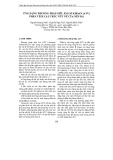
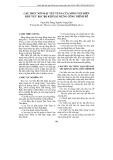
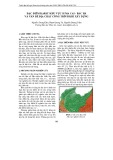
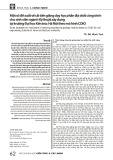
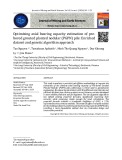
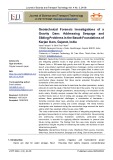
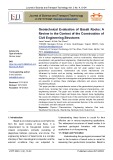






![Quy hoạch tổng thể Cà Mau: Tài liệu [mới nhất/chuẩn nhất]](https://cdn.tailieu.vn/images/document/thumbnail/2025/20250827/tghong1621@gmail.com/135x160/49401756278390.jpg)


![Bài giảng Hàng hải địa văn [chuẩn nhất]](https://cdn.tailieu.vn/images/document/thumbnail/2025/20250729/vijiraiya/135x160/43361753782101.jpg)
![Bài giảng Trắc địa cơ sở [mới nhất]](https://cdn.tailieu.vn/images/document/thumbnail/2025/20250729/vijiraiya/135x160/84_bai-giang-trac-dia-co-so.jpg)





![Atlas tài nguyên nước Việt Nam: Tài liệu [Mô tả/Hướng dẫn/Chi tiết]](https://cdn.tailieu.vn/images/document/thumbnail/2025/20250715/vijiraiya/135x160/348_tai-lieu-atlas-tai-nguyen-nuoc-viet-nam.jpg)
![Hệ thống câu hỏi ôn tập Vùng kinh tế [chuẩn nhất]](https://cdn.tailieu.vn/images/document/thumbnail/2025/20250709/kimphuong1001/135x160/76921752140578.jpg)
